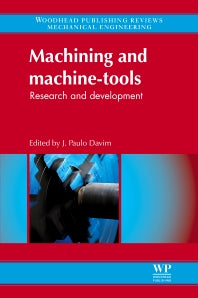Freshly Printed - allow 10 days lead
Couldn't load pickup availability
Machining and Machine-tools
Research and Development
J Paulo Davim (Edited by)
9780857091543, Elsevier Science
Hardback, published 10 May 2013
280 pages
23.4 x 15.6 x 2.2 cm, 0.56 kg
This book is the third in the Woodhead Publishing Reviews: Mechanical Engineering Series, and includes high quality articles (full research articles, review articles and case studies) with a special emphasis on research and development in machining and machine-tools. Machining and machine tools is an important subject with application in several industries. Parts manufactured by other processes often require further operations before the product is ready for application. Traditional machining is the broad term used to describe removal of material from a work piece, and covers chip formation operations including: turning, milling, drilling and grinding. Recently the industrial utilization of non-traditional machining processes such as EDM (electrical discharge machining), LBM (laser-beam machining), AWJM (abrasive water jet machining) and USM (ultrasonic machining) has increased. The performance characteristics of machine tools and the significant development of existing and new processes, and machines, are considered. Nowadays, in Europe, USA, Japan and countries with emerging economies machine tools is a sector with great technological evolution.
List of figures and tables List of abbreviations Preface About the contributors Chapter 1: Analysis of acoustic emission signal evolution for monitoring diamond-coated tool delamination wear in machining Abstract: 1.1 Introduction 1.2 Experimental set-up and methods 1.3 Results and discussion 1.4 Conclusions Chapter 2: High-performance machining of austenitic stainless steels Abstract: 2.1 Introduction 2.2 Properties of austenitic stainless steels 2.3 Machining study of austenitic stainless steels at high performance conditions 2.4 Conclusions Chapter 3: Forces monitoring in shape grinding of complex parts Abstract: 3.1 Introduction 3.2 Generality of screw rotors 3.3 Workpiece holder 3.4 Experimental tests 3.5 Results and discussion 3.6 Conclusions Acknowledgements Chapter 4: Optimization of minimum quantity lubrication in grinding with CBN wheels Abstract: 4.1 Introduction 4.2 Literature review 4.3 Wheel cleaning 4.4 Conclusions Chapter 5: Electrical discharge machining: study on machining characteristics of WC/Co composites Abstract: 5.1 Introduction 5.2 Principles of the EDM process 5.3 Machining experiments 5.4 Response surface modelling using Box–Behnken design 5.5 Response surface model for MRR and surface roughness 5.6 Results and discussion 5.7 Summary Acknowledgements Chapter 6: Conventional and unconventional hole making in metal matrix composites Abstract: 6.1 Introduction 6.2 Development of the secondary processes for MMCs: ‘need of the hour’ 6.3 Classification of MMCs based on the matrix material 6.4 Fabrication processes for MMCs 6.5 Conventional and unconventional machining processes 6.6 Conventional secondary processing of MMCs 6.7 Hole making in MMCs 6.8 Unconventional machining of MMCs Chapter 7: A laboratory machine for micro electrochemical machining Abstract: 7.1 Introduction 7.2 Development of the laboratory machine 7.3 Experimental work plan 7.4 Results and discussion 7.5 Conclusions Chapter 8: Cam-driven electromagnetic mechanical testing machine Abstract: 8.1 Introduction 8.2 Design and fabrication of the testing machine 8.3 Experimental workplan 8.4 Results and discussion 8.5 Conclusions Acknowledgment Index
Subject Areas: Mechanical engineering [TGB]


